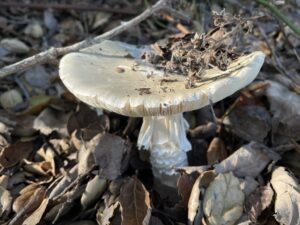In January 2007, six members of a Mexican-American family ate wild mushrooms they’d gathered from Wilder Ranch State Park, north of Santa Cruz. The matriarch was familiar with collecting wild mushrooms in Mexico, but here, surrounded by apparently similar mushrooms, she made a dangerous mistake: Among the mushrooms she fed her family was the infamous “death cap,” Amanita phalloides.
Through extraordinary medical efforts, five of the six people were saved. But others in California have not been so lucky. Dozens have lost their lives or their livers through the mistaken ingestion of our two deadly amanitas: the greenish-capped phalloides, an inadvertent European import (likely brought here on the roots of cork oak trees), and the native, deathly white “destroying angel,” Amanita ocreata.
All wild mushrooms, and amanitas in particular, must be treated with caution when being considered for the table. And yet, like wildflowers in the spring, the variety and beauty of their colors and forms can provide us with tremendous aesthetic pleasure when we happen upon them in a wet winter woodland. Water is the magic ingredient: Mushrooms are composed mostly of water, and there must be a surplus of moisture in the environment for them to grow. Unlike the wet and stormy summers of eastern North America, fall and winter is our Bay Area rainy season, and this is when we are most likely to see mushrooms of all kinds in the field.
- The death cap mushroom (Amanita phalloides) is the leading cause of fatal mushroom poisonings in California. Photo by Darvin DeShazer.
Mushrooms are ephemeral, spore-bearing structures produced by a hidden, long-lived fungal organism. Most amanitas are mycorrhizal (fungus/root), forming a symbiotic relationship with trees and shrubs. The underground mat, or mycelium, of elongate, interconnected fungal cells covers and penetrates the root hairs of woody plants. This mycelium greatly increases the ability of the tree or shrub to obtain water and nutrients, and in return, the plant’s photosynthesis provides the fungus with sugars.
The invasive and widespread Amanita phalloides fruit prolifically, and may displace native mushrooms, or even “cheat” their host trees, taking more than they give through an imbalanced nutrient exchange that seems to bypass some of the checks and balances of more long-standing symbiotic relationships. The death cap’s penchant for California live oak is well known, but it has also recently been documented with tanoak in Mendocino and Monterey pine in Marin.
Death caps can appear in irrigated areas as early as summer. Amanita ocreata, less common but equally poisonous, fruits later in the season. Destroying angels can be found from winter through spring in the thick duff beneath the canopy of coast live oak.
But amanita mushrooms are not intrinsically evil. There’s no risk in handling even a deadly amanita; to be harmed, you must eat it. And lest you think that is a preposterous idea, some amanita species are considered the most delectable edible mushrooms in the world.
Amanita caesarea, the delicious Caesar’s amanita of Italy, got its name because an emperor decreed, upon pain of death, that no one but he could eat this mushroom. Here in the Bay Area we also have amanitas that are coveted for the table. The handsome, pale apricot-capped Amanita velosa, or “springtime amanita,” is the best of our local edibles, with a sweet and nutty flavor. It fruits in winter and spring at the drip line of live oaks and beyond, sometimes far out into a grassy field. Color and shape in amanitas is highly variable, and you need long experience to develop your identification skills enough to safely collect these mushrooms. No amanita, no matter how delicious, is worth your life.
Growing under our Bay Area live oak and pines is another graceful and edible group of amanitas called “grisettes.” These are sometimes tall and always stately mushrooms that have plain gray or brown caps.
Subtlety is not the forte of the brilliantly red Amanita muscaria, locally common under Monterey pine.With its dotted white cap, it looks as though it has escaped from the pages of a fairy tale!
Many other species of amanitas, elegant and colorful, occur in the Bay Area. A slow walk through our wet and verdant winter woods can introduce you to many members of this group of fascinating, sometimes deadly, and, at the very least, visually delicious mushrooms: our fungal flowers of winter.
To learn more about wild mushrooms, visit the website of the Bay Area Mycological Society at www.bayareamushrooms.org.

.jpg)




